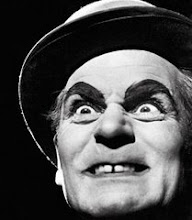
Fig. 1 Rear projection with purpose
Alfred Hitchcock broke new ground in 'Strangers On A Train' (1951), his most in-depth psychological exploration of psychopathic behavior passing as normality, to date. Consequently, 'Strangers' might be called Hitch's creepiest picture. 'Shadow Of a Doubt' (1943) was the director's first foray into disturbingly quiet innuendo, with mild-mannered Joseph Cotton as one of the screen's most balefully nuanced characters, but Hitch loved the limitations of trains - nowhere to go but over the edge - and 'Strangers' is all about being cornered by such rail-bound limits.
The plotline is simple: a genial chance meeting between two men on a train leads to, well, murder. And quid pro quo.
As some critics have pointed out, 'Strangers' is also Hitch's development of a homoerotic subtext. Bruno (Robert Walker), 'comes on' to Guy (Farley Granger) on more levels than just attraction. Several viewings are necessary to explore the film's multiple levels, and the experience is always compelling.
No spoilers here, but it must be mentioned that the merry-go-round disaster is one of Hitch's most violent and startling sequences. The special effects, all done up in nightmarish monochrome, introduce a most unexpected sense of loss of control, not thought possible in light of the calm control of the picture up to this point.
Dimitri Tiomkin's score is subtle except in the right places, such as the triumphant movement of great trains out of great stations, and in one of the picture's finest 'psychotic' moments, when Guy's mom reveals the painting she's been working on: a horrific portrait that perverts deKooning's 'Woman' series. The scoring behind the climactic tennis match is lightly-stringed and empathetically worried - perfect for Hitch's to-and-fro tension.
Hitch was in top form with one of his favorite cameramen, Bob Burks. Their exploitation of the murder victim's obnoxious and face-distorting glasses, the progression of the merry-go-round operator under the raging contraption (played by Harry Hines, who was Mr Miggles in 'Harvey') and Bruno's extremely 'normal'-appearing close-ups, are among the most memorable shots in the film.
I know of people who can't sit through this picture because it is too creepy. Hitch would perhaps be pleased with such an effect, though the resolve at the end is neat and complete. For the viewer, it is always a pleasure to brand a film as a masterpiece, and in this case of 'Strangers On a Train', it is also a cinch.


No comments:
Post a Comment